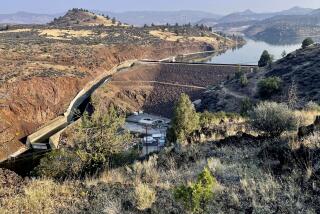Hearst Deal Needs Full Disclosure
- Share via
It’s no secret that there is strong support for preserving the 82,000-acre Hearst Ranch on California’s Central Coast. And it’s no secret that the Hearst Corp., on behalf of descendants of the legendary publisher William Randolph Hearst, is pressuring the state to approve a deal for the land -- $95 million, to be paid primarily out of state bond funds -- by the end of May, or else.
Unfortunately, what remains a closely guarded secret is the exact nature of the deal. And that means that the Hearst ultimatum should be rejected until the public gets a complete picture of what its money will buy.
Along California’s incomparable coast, there is no property more spectacular than Hearst Ranch. Stretching for 18 miles along Highway 1, it is renowned for its shoreline bluffs and ocean views; its pristine beaches, where elephant seals rear their young; and its mountaintops and rolling foothills, where elusive species like pumas and condors make their home. Without question, this is a magnificent natural landscape and recreational resource worth preserving. But will the deal now being offered to the state truly accomplish that goal?
Public disclosure of the Hearst Corp.’s proposal has been limited to a single printed page of “general goals,” thanks to confidentiality agreements the corporation required as a condition of negotiations. There’s no doubt that it represents an improvement over the plan Hearst originally and unsuccessfully proposed for portions of the ranch: a large-scale housing, hotel and golf resort development. However, the details are sketchy, and Californians could be entering into a deal that would allow Hearst to have its cake and eat it too.
Here’s what we know: West of Highway 1, the corporation would sell to the state some -- but not all -- of its 2,000 acres of beaches and oceanfront land, and it would reserve the right to build and operate a 100-room hotel in San Simeon Village. East of Highway 1, Hearst would keep the entire 80,000 acres but agree to restrict its development through an agricultural easement, except for 27 individual 160-acre parcels to be developed as estate homes. There would be no public access at all on the 80,000 acres east of Highway 1, not even to the historic Mission San Antonio Trail that connects the ranch to the neighboring Los Padres National Forest.
Before the state agrees to the deal, the public must get answers to some critical questions: Is the price tag justified? West of the highway, what land, exactly, would become public property? How would existing access to the beaches be affected? East of the highway, what are the details of the “estate home” development? Would the state or Hearst control the agricultural easement? How would it be enforced? How would endangered species and habitat be protected from future agricultural uses, and would such uses be limited to existing cattle operations, or could they be intensified to include such things as vineyards, row crops, feedlots, or packing and processing plants?
Such issues must not be left to chance or to closed-door negotiations. Californians have a right to a deal that will preserve their fundamental right to use the state’s beaches, provide access to trails from the coast to Los Padres National Forest and Ft. Hunter Liggett, and ensure public control of a narrowly tailored, enforceable agricultural easement on the acreage east of Highway 1.
Nor should the state act precipitously in the face of a negotiating tactic like Hearst’s self-imposed May deadline. As other recent state land acquisitions have shown -- for example, the historic deals for Ahmanson Ranch, the Ballona Wetlands, the Cargill Salt Ponds in San Francisco Bay and the Cornfield and Taylor Yard along the Los Angeles River -- it takes time and attention to detail to ensure that the public gets a fair shake. These deals were subjected to intense public scrutiny, even though they were simpler, involving the outright sale of property rather than the mix of private and public control and ownership that Hearst is proposing.
By their approval of $10 billion in natural-resource bonds since 2000, Californians have shown that they want to protect the state’s lands and water supplies for future generations. We value our unparalleled landscapes and natural resources. We also know the value of a dollar.
If the Hearst Corp. and family members are serious about asking the public to pay them not to develop their ranch, they must show us that we will get our money’s worth. After all, this high-profile deal is likely to influence similar transactions for years to come.
If ever there was a time to read the fine print, this is it. But that would require public access to information and adequate time to consider it. We urge Gov. Arnold Schwarzenegger and his administration to insist on both.
Joel R. Reynolds is senior attorney and director of the urban program for the Natural Resources Defense Council. Susan Smartt is executive director of the California League of Conservation Voters.
More to Read
Inside the business of entertainment
The Wide Shot brings you news, analysis and insights on everything from streaming wars to production — and what it all means for the future.
You may occasionally receive promotional content from the Los Angeles Times.










